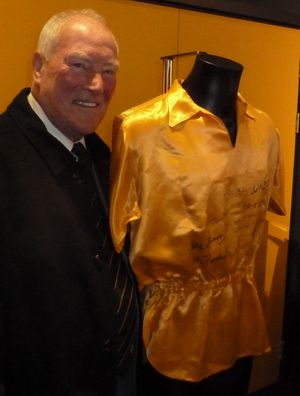The story of Wolves' old gold shirts 70 years on from special Honved match
An iconic feature of Wolves’ most famous game, the 1954 victory over Honved, was the shiny gold satin shirts worn by Stan Cullis's team, writes Steve Gordos.
Watch more of our videos on ShotsTV.com
and on Freeview 262 or Freely 565
Yet, contrary to urban myth, they were not specially commissioned for the series of floodlit games, highlight of which was the 3-2 win over the Hungarian maestros on December 13, 70 years ago.
Wolves decided to experiment with “luminous” gold shirts in the winter of 1951, aware that the old gold they wore in those days was not easily visible on dark winter afternoons. Floodlights were not permitted in Football League or FA Cup games at the time so Wolves thought the brighter shirts would be a good idea.
The shirts were first used in the second half of the game against Charlton at Molineux on Saturday, November 24, 1951. It was an ideal day to test the new shirts as the weather was dull and it rained throughout the match. The shirts were supposed to be gold but the Birmingham Gazette did not go along with that as it reported: “In the second half of the game against Charlton Wolves players tried out a device for finding one another in the gloom of a dark November day. They wore yellow fluorescent shirts and they shone out like fireflies.”

Under the heading “Lighter side” there was also a reference in the Daily Mirror: “There were gasps of astonishment at Molineux on Saturday when Billy Wright, Wolves’ skipper, led his men out for the second half wearing vivid yellow luminous shirts. In the gathering gloom the Wolves players seemed to float like phantoms across the pitch.”
It was intended as a device to help Wolves more easily find each other but the shirts brought a slight snag, as the Gazette explained: “As Mr A H Oakley, Wolves director and an England selector, pointed out, the Charlton players could see Wolves better than Wolves could see them.” Arthur Oakley added: “It was a good day to try them out and I think they were effective. I think fluorescent shirts are bound to come for mid-winter games but for full effect both sides should wear them.”
Charlton manager Jimmy Seed said: “A good idea. You could see the players and what they were doing, but I’m not sure whether the shirts of other colours would be so effective as yellow ones.” Wolves boss Stan Cullis said: “The shirts are made of a sort of nylon. We’ve had two sets for six weeks and have tried them out in practice games.”

The Gazette’s match report was not too impressed: “If their play had shone like the fluorescent yellow shirts they wore for the first time in the second half of their home game against Charlton Athletic the Wolves could have claimed as their own the town’s motto ‘Out of darkness cometh light.’ But it didn’t, and the shirts which tickled the crowd immensely, only lit up the gloom that hung over the pitch.” After being held 1-1 at half-time, the brightly-clad Wolves went 2-1 up 12 minutes from time through Roy Swinbourne only for Chris Duffy to level for Charlton six minutes from the end.
Wolves used the shirts in the second half of their next two home games. They may have helped in the 4-0 win over Middlesbrough as three of the goals came in the brighter shirts, scored by Jesse Pye (56 and 86 minutes) and Swinbourne (80). However, the shirts did not have the same magical effect when Manchester City scored the only goal of the second half when they held Wolves to a two-all draw on December 15, 1951, former Molineux hero Dennis Westcott hitting an equaliser after 62 minutes.

The shirts were not used again in League games. It may well have been that the Football League decided they did not conform to their regulations. No-one seems to know for certain the reason why they were shelved. It would be nearly two years before Wolves again wore luminous shirts – for the first of their floodlit friendlies, against South Africa in September 1953. The same strip was also used in the famous wins under lights over Honved and Spartak.
It was after winning the First Division title, as the top flight was then known, that Wolves dropped old gold as their official colour and opted for gold. The new colour, gold, seen on the opening day of the 1954-5 season, was far brighter than old gold though not quite as vivid as the floodlight shirts. Many newspapers – both national and local – and some commentators on TV and radio still wrongly refer to Wolves’ colours as “old gold”.
To mark the 70th anniversary of the win over a Honved side who included six of the Hungary side who had humiliated England 6-3 at Wembley in November 1953, the club have brought out a replica of the famous satin gold shirt.





